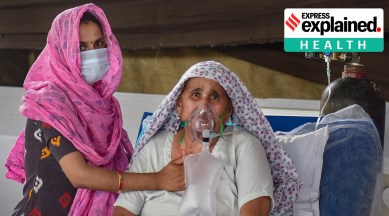Explained: How to be a caregiver of a Covid-19 patient
A caregiver is one who should stay home and monitor the health of Covid patients. The Indian Express finds out how to be a caregiver of a Covid patient without infecting yourself.

A caregiver is one who should stay home and monitor the health of Covid patients. The Indian Express finds out how to be a caregiver of a Covid patient without infecting yourself.
Newsletter | Click to get the day’s best explainers in your inbox
Who can be a caregiver?
He/she can be anyone who is fit and can take care of a patient in home isolation 24×7 following due precautions. The person can be a family member or even a volunteer in case a family member is not available. Caregivers can take care of mild/asymptomatic patients and has to be a regular communication link with the hospital or the treating doctor.
What are the instructions for caregivers?
Caregivers should wear triple layer masks while in the same room with Covid patient. The mask must be changed immediately if it gets dirty or wet due to secretions. They should always maintain hand hygiene i.e hands should be washed for a minimum of 40 seconds with soap and water. Before and after giving food to the patient, measuring body temperature, Oxygen concentration etc as well. hand hygiene should be maintained with alcohol-based hand sanitizer apart from hand washing if one comes in contact with a patient while taking his/her care. They should also self monitor their health on a regular basis and should get tested in case of any symptoms like fever, cough, difficulty in breathing etc.
How should they clean the room and utensils of Covid patients?
Food must be provided to Covid positive patients in his/her room. Utensils and dishes used by the patient must be cleaned with soap/detergent using hot water while wearing gloves and a face mask. If a patient is asymptomatic and is in a stable condition, he/she can wash the dishes themselves. Frequently touched contact items like door handles, table tops should be cleaned with 1% mixture of sodium hypochlorite. If
How should clothes of a Covid positive patient be washed?
Clothes should be dipped in 1% solution of sodium hypochlorite for 30 minutes so as to sanitise them fully, later they can be washed with soap/detergent wearing gloves and masks, said Dr Rajesh Bhaskar, Covid nodal officer of Punjab.
Things which caregivers should avoid.
They should avoid direct contact with body fluids of the Covid-19 positive patient, particularly oral or respiratory secretions. Avoid sharing personal items with patients as well as exposure to potentially contaminated items in his immediate environment e.g dishes, drinks, used towels or bed linen. “Caregivers should provide food to patients outside the room. If the patient is not in a position to get up from the bed, he/she should be taken to the hospital or the doctor should be informed rather than a caregiver frequently entering the room of the patient,” added Dr Bhaskar.
What are the things to be monitored by a caregiver?
Caregivers should make a chart of body temperature, pulse, oxygen level and should keep a proper record of this chart for future reference with the treating doctor. Sugar and blood pressure of comorbid patients should also be checked on a regular basis and entered in the record chart. Caregivers should help patients in proning, breathing exercises and should be in regular touch with doctors if oxygen level dips or any other complication arises so as to decide as to whether the patient is to be shifted to hospital immediately or not. Caregivers should help patients make their daily time table starting from morning exercises, meditation, gargles steam, eating meals, medicines at regular intervals and above all, to have ample rest as well, informed Dr Bhaskar.